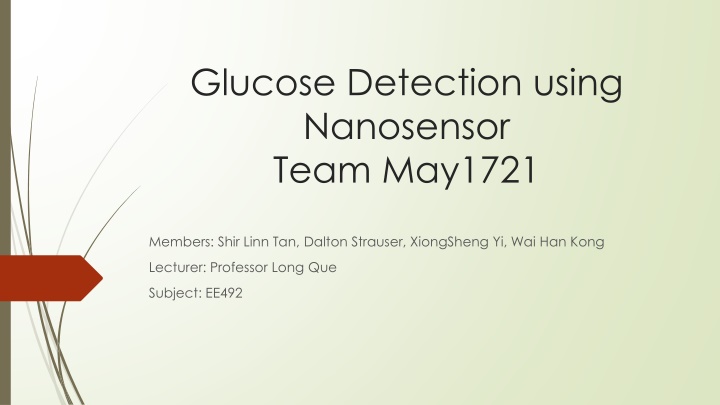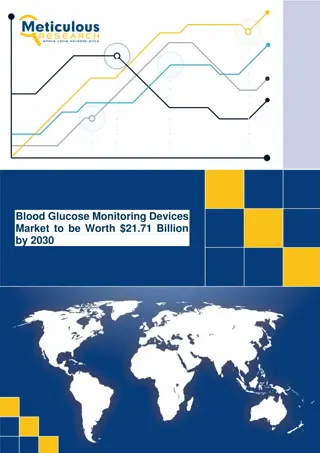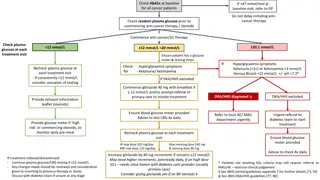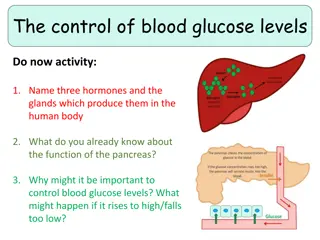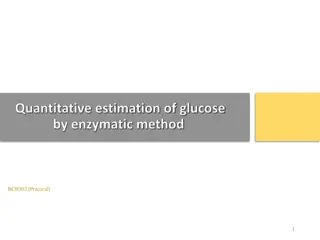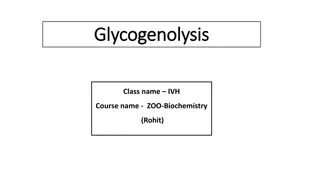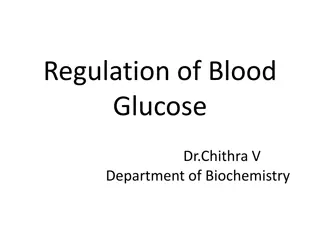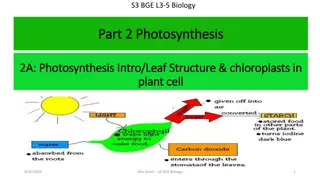Disposable Glucose Nanosensor Development Project
This project aims to develop a disposable glucose nanosensor and testing method to detect a range of concentrations. The goal is to create a low-cost and easy-to-fabricate nanosensor by designing an effective fabrication process. Steps involve cleaning the microscope slide, depositing titanium and aluminum, anodizing in an acidic solution, and sputtering gold for glucose testing. The system includes a computer, spectrometer, light source, and fiber optic fluorescence spectrometer for data collection.
Download Presentation

Please find below an Image/Link to download the presentation.
The content on the website is provided AS IS for your information and personal use only. It may not be sold, licensed, or shared on other websites without obtaining consent from the author.If you encounter any issues during the download, it is possible that the publisher has removed the file from their server.
You are allowed to download the files provided on this website for personal or commercial use, subject to the condition that they are used lawfully. All files are the property of their respective owners.
The content on the website is provided AS IS for your information and personal use only. It may not be sold, licensed, or shared on other websites without obtaining consent from the author.
E N D
Presentation Transcript
Glucose Detection using Nanosensor Team May1721 Members: Shir Linn Tan, Dalton Strauser, XiongSheng Yi, Wai Han Kong Lecturer: Professor Long Que Subject: EE492
Project Statement Develop a disposable glucose nanosensor and develop a testing method to detect a range of concentrations Goal / Purposes Develop a low cost and easy to fabricate nanosensor Design an effective fabrication process for the nanosensor
Fabrication Process Step 1 Start with Fisherfinest Premium Clipped Corner microscope slide Microscope slide (75x25x25mm) 1. Thoroughly clean and blow dry with nitrogen gas -- remove any contaminates which can inhibit fabrication 1. Deposit 20nm of titanium on the glass using electron beam physical vapor deposition(EBPVD) Step 2 Titanium (20nm) EBPVD: 1. 2. 3. One of the physical vapor deposition (PVD) techniques Source material is heated by an intense beam of electrons Molecules evaporate and travel through a vacuum chamber Target surface is coated with these molecules until desired thickness is achieved 4.
Fabrication Process Step 3 3. Deposit 2nm of aluminum using EBPV -aluminum adheres better to Ti Aluminum (2nm) 4. Submerge in acidic solution to anodize -sulfuric acid with glycol -AAO (Anodic Aluminum Oxide) Step 4 Acidic solution
Fabrication Process Step 5 5. Use sputtering process to deposit a thin layer of gold -we will perform our glucose testing directly on this surface Gold (10nm) Sputtering : Create a gaseous plasma and accelerate the ions into the source material Source is eroded by the incident ions Atoms are ejected from the source due to cascading energy transfers Ejected atoms are deposited onto the target and bind forming a thin layer
System Computer Spectrometer Light source Dual screen computer: OceanView Spectroscopy Software Record collected data and transfer to Microsoft Excel Fiber Optic Fluorescence Spectrometer: Capable of fluorescence measurements (360 1000nm) Ocean Optics HL-2000: Source of light Fiber probe: Transfers light and acts as our detector Stage: Area to align AAO and measure the reflected wavelength Fiber probe & Stage
Testing 1. Measure the AAO (anodic aluminum oxide) without any glucose solution 2. Obtain a wavelength versus intensity graph using OceanView 3. Deposit a fixed amount of glucose solution (5ml) onto every AAO sample using a precision pipette 4. Place the AAO on a hot plate of 80oC to speed up the evaporation process 5. After complete evaporation, the AAO is placed under the fiber probe to obtain the wavelength-intensity graph 6. Repeat step 3 to 5 for two more times with exactly the same amount of glucose solution (5ml)
- The process of creating AAO- metal can utilize an inexpensive and simple method of electrochemical metal deposition Methodology - The AAO membrane AAO self- organizes into a honeycomb like structure. This structure is high in density and uniform which is ideal for creating a reproducible experiment. The pores have a diameter of around 80nm. The diameter is controllable by the oxidation process. This nanostructure is great because it allows us to have a tight design parameter without needing to use a complicated process of photolithography and etching which can have high margins of error. SEM Image of AAO Coating Obtained in Acidic Solution - This electrochemically obtained porous layer of AAO is used as a sensor to detect glucose optically
Figure A shows the nanopore structure before any glucose is deposited. Figure B shows the nanopore structure with small amount of glucose deposited. Figure C shows the nanopore with high concentration of glucose.
Results of Different Glucose Concentrations Below are the shifts in wavelength by combining all data sets from a single AAO sample at different applied concentrations of glucose. Our AAO samples were able to detect glucose concentrations from a range of 0.53mg/mL to 20mg/mL with observable wavelength shifts.
Shift of Wavelength vs Glucose Concentration The figure above demonstrated that the shift of wavelength in terms of glucose concentration is in a linear relationship. This allows wavelength data to be translated into a specific concentration of glucose.
Complete version of glucose detection sensor
Conclusion Success in clearing the criteria of the project. The chips are disposable and our design is simple and easy to reproduce. Our chip is not ready for commercial use, but our data shows promise in the possibilities. The mean normal blood glucose level for humans is about 1mg/mL, which we were able to detect small changes at though we believe the sensor is not accurate enough on the low end to be used reliably for human blood sugar measuring. Animals have wildly different glucose concentrations so it is possible that our sensor could be useful for application involving them instead.
References (1) K. Besteman et al, Enzyme-coated carbon nanotubes as single- molecule biosensors, Nano Letters, vol. 3, no. 6, 727-730, Mar. 2003. (2) T. Zhang et al, Nanostructured optical microchips for cancer biomarker detection, Biosensors and Bioelectronics, vol. 38, no. 1, 382-388, Oct. 2012. (3) P. Pathank and L. Que, Characterization of field effect transistor biosensors fabricated using layer-by- layer nanoassembly process, Journal of Nanoscience and Nanotechnology, vol. 15, no. 12, 9689-9692, 2015.
